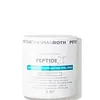What's inside
What's inside
 Key Ingredients
Key Ingredients

 Benefits
Benefits

 Concerns
Concerns

 Ingredients Side-by-side
Ingredients Side-by-side

Water
Skin ConditioningGlycolic Acid
BufferingGlycerin
HumectantSodium Hydroxide
BufferingLactobacillus Ferment
Skin ConditioningXanthan Gum
EmulsifyingButylene Glycol
HumectantCola Nitida Seed Extract
Skin ConditioningPinus Koraiensis Seed Extract
PerfumingPaullinia Cupana Seed Extract
Skin ConditioningAhnfeltia Concinna Extract
Skin ConditioningPhenoxyethanol
PreservativeChlorphenesin
AntimicrobialSodium Dehydroacetate
PreservativeSodium Benzoate
MaskingSorbic Acid
PreservativeWater, Glycolic Acid, Glycerin, Sodium Hydroxide, Lactobacillus Ferment, Xanthan Gum, Butylene Glycol, Cola Nitida Seed Extract, Pinus Koraiensis Seed Extract, Paullinia Cupana Seed Extract, Ahnfeltia Concinna Extract, Phenoxyethanol, Chlorphenesin, Sodium Dehydroacetate, Sodium Benzoate, Sorbic Acid
Oat Amino Acids
Skin ConditioningRetinol
Skin ConditioningWater
Skin ConditioningButylene Glycol
HumectantSodium Lactate
BufferingPhytic Acid
PPG-5-Ceteth-20
EmulsifyingRosa Centifolia Flower Water
Skin ConditioningHamamelis Virginiana Water
AstringentSalicylic Acid
MaskingThreonine
Glutamic Acid
HumectantSerine
MaskingAspartic Acid
MaskingArginine
MaskingAlanine
MaskingProline
Skin ConditioningValine
MaskingHistidine
HumectantGlycine
BufferingLysine
Skin ConditioningChamomilla Recutita Flower Extract
MaskingCamellia Sinensis Leaf Extract
AntimicrobialAscorbic Acid
AntioxidantRetinyl Palmitate
Skin ConditioningTocopheryl Acetate
AntioxidantAloe Barbadensis Leaf Juice
Skin ConditioningBorago Officinalis Seed Oil
EmollientSymphytum Officinale Leaf Extract
Skin ConditioningCitrus Limon Peel Extract
EmollientCitrus Aurantifolia Peel Extract
CleansingCitrus Aurantium Dulcis Fruit Extract
MaskingCitrus Tangerina Peel Extract
AstringentMentha Piperita Extract
CleansingSalvia Officinalis Leaf Extract
CleansingZingiber Officinale Root Extract
MaskingPhenoxyethanol
PreservativeSodium Hydroxide
BufferingAminobutyric Acid
Potassium Sorbate
PreservativeSodium Benzoate
MaskingCaprylic/Capric Triglyceride
MaskingPEG-8 Dimethicone
EmulsifyingLeucine
Skin ConditioningSodium Ascorbyl Phosphate
AntioxidantLimonene
PerfumingBenzoic Acid
MaskingTyrosine
MaskingPhenylalanine
MaskingIsoleucine
Skin ConditioningCitric Acid
BufferingOctyldodecanol
EmollientSilica
AbrasiveSodium Propoxyhydroxypropyl Thiosulfate Silica
Oat Amino Acids, Retinol, Water, Butylene Glycol, Sodium Lactate, Phytic Acid, PPG-5-Ceteth-20, Rosa Centifolia Flower Water, Hamamelis Virginiana Water, Salicylic Acid, Threonine, Glutamic Acid, Serine, Aspartic Acid, Arginine, Alanine, Proline, Valine, Histidine, Glycine, Lysine, Chamomilla Recutita Flower Extract, Camellia Sinensis Leaf Extract, Ascorbic Acid, Retinyl Palmitate, Tocopheryl Acetate, Aloe Barbadensis Leaf Juice, Borago Officinalis Seed Oil, Symphytum Officinale Leaf Extract, Citrus Limon Peel Extract, Citrus Aurantifolia Peel Extract, Citrus Aurantium Dulcis Fruit Extract, Citrus Tangerina Peel Extract, Mentha Piperita Extract, Salvia Officinalis Leaf Extract, Zingiber Officinale Root Extract, Phenoxyethanol, Sodium Hydroxide, Aminobutyric Acid, Potassium Sorbate, Sodium Benzoate, Caprylic/Capric Triglyceride, PEG-8 Dimethicone, Leucine, Sodium Ascorbyl Phosphate, Limonene, Benzoic Acid, Tyrosine, Phenylalanine, Isoleucine, Citric Acid, Octyldodecanol, Silica, Sodium Propoxyhydroxypropyl Thiosulfate Silica
Alternatives
Ingredients Explained
These ingredients are found in both products.
Ingredients higher up in an ingredient list are typically present in a larger amount.
Butylene Glycol (or BG) is used within cosmetic products for a few different reasons:
Overall, Butylene Glycol is a safe and well-rounded ingredient that works well with other ingredients.
Though this ingredient works well with most skin types, some people with sensitive skin may experience a reaction such as allergic rashes, closed comedones, or itchiness.
Learn more about Butylene GlycolPhenoxyethanol is a preservative that has germicide, antimicrobial, and aromatic properties. Studies show that phenoxyethanol can prevent microbial growth. By itself, it has a scent that is similar to that of a rose.
It's often used in formulations along with Caprylyl Glycol to preserve the shelf life of products.
Sodium Benzoate is a preservative. It's used in both cosmetic and food products to inhibit the growth of mold and bacteria. It is typically produced synthetically.
Both the US FDA and EU Health Committee have approved the use of sodium benzoate. In the US, levels of 0.1% (of the total product) are allowed.
Sodium benzoate works as a preservative by inhibiting the growth of bacteria inside of cells. It prevents the cell from fermenting a type of sugar using an enzyme called phosphofructokinase.
It is the salt of benzoic acid. Foods containing sodium benzoate include soda, salad dressings, condiments, fruit juices, wines, and snack foods.
Studies for using ascorbic acid and sodium benzoate in cosmetics are lacking, especially in skincare routines with multiple steps.
We always recommend speaking with a professional, such as a dermatologist, if you have any concerns.
Learn more about Sodium BenzoateSodium Hydroxide is also known as lye or caustic soda. It is used to adjust the pH of products; many ingredients require a specific pH to be effective.
In small amounts, sodium hydroxide is considered safe to use. However, large amounts may cause chemical burns due to its high alkaline.
Your skin has a natural pH and acid mantle. This acid mantle helps prevent harmful bacteria from breaking through. The acid mantle also helps keep your skin hydrated.
"Alkaline" refers to a high pH level. A low pH level would be considered acidic.
Learn more about Sodium HydroxideWater. It's the most common cosmetic ingredient of all. You'll usually see it at the top of ingredient lists, meaning that it makes up the largest part of the product.
So why is it so popular? Water most often acts as a solvent - this means that it helps dissolve other ingredients into the formulation.
You'll also recognize water as that liquid we all need to stay alive. If you see this, drink a glass of water. Stay hydrated!
Learn more about Water